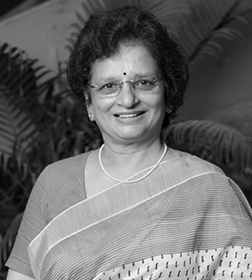Find the programme that meets your requirements and aspirations.
Apply nowShapers Book Series
Shapers of Business Institutions is a book series of six volumes that explores the shaping of long-standing Indian business organizations, that have withstood the test of time and grown exponentially since the economic liberalization in 1991 to become institutions in their own right.
What makes some organizations long-lasting? How come some chart a new course which others like to follow? Does this characterize them as ‘business institutions’ rather than merely ‘good companies’?
How do two business leaders with radically different management styles embed values and practices into the sinews of a corporation through their thoughts and actions? Each book in the series focuses on one such institution that shot into exemplary growth in the last half a century.

Authors

R. Gopalakrishnan
R. Gopalakrishnan is an author, speaker and corporate advisor, with a career spanning over 50 years. He spent 31 years in Hindustan Unilever Limited, where he rose to be vice chairman, followed by 19 years in Tata Sons as a director. He now serves as non-executive chairman of Castrol India; an independent director of Hemas Holdings PLC, Sri Lanka; executive-in-residence of S.P. Jain Institute of Management and Research (SPJIMR), Mumbai and distinguished professor of IIT, Kharagpur. He has authored nine books so far, notably A Comma in a Sentence, Six Lenses and Doodles on Leadership.

Tulsi Jayakumar
Tulsi Jayakumar an alumnus of the prestigious Delhi School of Economics, is a Professor of Economics and Chairperson, Family Managed Business at SPJIMR, Mumbai. She has to her credit globally acclaimed cases published in international academic journals, besides contributing thought-provoking articles in national business papers and magazines.

Pallavi Mody
Pallavi Mody, professor at SPJIMR, feels that her core competence lies in simplifying jargon. A prolific writer of business cases and op-eds in financial dailies, she is deeply interested in value creation by corporates who build and lead the India story

Sushmita Srivastava
Sushmita Srivastava has an inordinate passion for teaching, executive education, research and consulting. After completing her fellow programme in management from XLRI, Jamshedpur, she left Tata Steel to join SPJIMR, Mumbai, as Associate Professor in HRM and OB areas. Her areas of interest are Leadership and Change Management, Talent Management and Corporate Entrepreneurship.

M. Suresh Rao
M. Suresh Rao is alumnus of IIM Ahmedabad. He was chairperson, Centre for Entrepreneurship at SPJIMR, following a career in corporate entrepreneurship. He completed a stint as CEO of a start-up telecom company before he took to academics. Professor Rao has participated in global programmes conducted by Harvard Business School and Babson for Entrepreneurship faculty and is among the pioneering faculty for entrepreneurship in B-Schools in India. The Centre for Entrepreneurship at SPJIMR conducts the first-of-its-kind Start Your Business and Grow Your Business programmes for aspiring and early growth stage entrepreneurs.
Vidyut Lata Dhir
Vidyut Lata Dhir is professor of Leadership & Organizational Behaviour and Group Head—Design Thinking at SPJIMR. She is a recipient of the Erasmus Mundus Scholarship (2014) by the European Union for Interdisciplinary Bridges for Indo-European Studies. A licensed psychologist, she pioneered ‘Vishwas’, an initiative to promote mental well-being in organizations. As a behavioural scientist, she designs and delivers management development programmes across industries. Her research interest lies in decoding life journeys related to leadership development and organizational commitment.
Books
-
How TCS Built an Industry for India
What makes some organizations long-lasting? How come some chart a new course that others like to follow?
Does this characterize them as ‘business institutions’ rather than merely ‘good companies’? How do two business leaders with radically different management styles embed values and practices into the sinews of a corporation through their thoughts and actions?
These are some vital questions for India’s economic growth that find resonance in the incredible journey of India’s largest software exporter, Tata Consultancy Services (TCS). The narrative relives the highs and lows in the life of this multibillion-dollar enterprise, as seen through the eyes of its architects—Faqir Chand Kohli (96), the founder, and his successor, S. Ramadorai (75). Between them, they spent 40 years making TCS an admirable industry leader and a corporation with agility, innovation, and scale.
Based on interviews with Kohli and Ramadorai, the authors provide an insider’s account of their grand vision of igniting India’s IT revolution. From the evolution of the offshoring model to harnessing the enormous opportunity offered by the Y2K problem, they offer rare insights into a company that they built, brick by brick.
How TCS Built an Industry for India is the first book in the series, Shapers of Business Institutions, and is a unique blend of a must-read business biography and a management classic.
Authors: R. Gopalakrishnan, Tulsi Jayakumar
To buy the book, click here
-
How Anil Naik Built L&T's Remarkable Growth Story
How is a ‘Shaper’ different from a manager and a business leader? A Shaper operates with a long-term vision and successfully changes the trajectory of the company to make it future-ready, in the way Anil Naik shaped the future of Larsen & Toubro (L&T).
The narrative traces the spectacular five-decade-long journey of Anil Naik as a junior engineer from the shop floor to the position of MD, CEO, and chairman. The story traverses through the parallel life journeys of L&T and Naik and witnesses their trials and tribulations.
Naik built the growth trajectory of L&T on the foundation of ‘value creation’ and transformed the company into an agile and competitive business conglomerate. Based on a series of personal interviews with Naik and his team, the book explores Naik’s mindset and actions that transformed L&T into a leading Indian MNC with a global footprint in fields as diverse as defence, nuclear power, and aerospace to financial services, IT, and engineering services.
How Anil Naik Built L&T’s Remarkable Growth Trajectory is the second book in the series, Shapers of Business Institutions. The book reveals ‘The Naik Way’—new leadership and management theories as a catalyst to growth.
Authors: R. Gopalakrishnan, Pallavi Mody
To buy the book, click here
-
How Kiran Mazumdar-Shaw ‘Fermented’ Biocon
Companies and businesses can be built into great institutions, which are more than engineered processes and ingredients; they are live organisms with emergent conditions. It is these emergent conditions that bring an institution alive. However, few entrepreneurial leaders are sometimes charged with motivation and drive that is dramatically different. These business folk break the mold of prevalent thinking, setting an organization on a new trajectory. They appear to operate with the rainforest rules, which are quite different from the model of cultivated agriculture in which you attempt to control and guide environmental factors to maximize efficiency and replicability. In the rainforest, you accept the environment and within that, you seek effectiveness and novelty.
The narrative of Biocon, India’s first and only modern biotechnology institution that has produced significant research and commercial value, and its founder, Kiran Mazumdar Shaw, resemble the application of these rainforest rules.
How Shaw cultivated Biocon’s DNA is a first-hand, inspiring account of the company, which was founded in India and led by an accidental, yet immensely successful woman entrepreneur, and has evolved to become an exemplary institution valued at $6 billion, with around 11,000 knowledge workers. In a series of personal interviews with Kiran and several associates of Biocon, the authors—seasoned business leader, R. Gopalakrishnan and management academic, Sushmita Srivastava—for the first time ever, trace the options that opened up during Kiran’s journey, understand how she made her choices and the outcomes, and then trace the trajectory taken by the institution.
The third book in the series, Shapers of Business Institutions, How Kiran Mazumdar Shaw Fermented Biocon, offers both instructional and inspirational perspectives for aspirants in management and entrepreneurship.
Authors: R. Gopalakrishnan, Sushmita Srivastava
To buy the book, click here
-
How Deepak Parekh Grew HDFC Group Exponentially
Parekh identified the one defining value of the Indian middle class – their honour – as an intangible asset, which would never let his business down.
The 1970s in India were dark times of high tax slabs, land sharks and black money. When loans were a last resort meant for emergencies and buying a house was beyond aspiration, possible only at retirement, nobody was willing to bet on the repayment capacity of the ignored middle class, except one man. This invisible class went on to become the primary potential customer base for Housing Development Finance Corporation (HDFC). The rest as they say is history.
While HDFC was Hasmukh Thakordas Parekh’s brainchild, it was his nephew Deepak Parekh who shaped it. Parekh left a comfortable overseas job with a plum salary and exclusive perks to join his uncle’s mortgage company at a 50 per cent pay cut. He nurtured HDFC to become India’s largest and cleanest financial conglomerate—not just in housing finance, but later in banking, asset management and insurance too.
What were Parekh’s mindset, behaviour and actions in transforming HDFC Group into a leading financial powerhouse in India? What makes Parekh a game changer in the financial world? How Deepak Parekh Grew HDFC Group Exponentially is the fourth book in the series, Shapers of Business Institutions, and is a must-read for its rare yet untold insights into the story of a shaper who breathed his own values of integrity and accountability into the DNA of an institution that still remains true to its middle-class values. Based on personal interviews with Deepak Parekh, his family, friends and peers, the narrative is a unique blend of a must-read business biography and a management classic.
Authors: R. Gopalakrishnan, Vidyut Lata Dhir
To buy the book, click here
-
How Harsh Mariwala 'Groomed' Marico
‘I had to learn the business virtually by the seat-of-my-pants, which gave me first-hand knowledge of how traditional Indian businesses are run.’
Harsh Mariwala, just out of college, joined Bombay Oil Industries Ltd (BOIL) as the third-generation scion in his family’s traditional spice-trading and consumer oil manufacturing business. He learned the key drivers of growing a profitable consumer product business in the field in the inhospitable Maharashtra and Gujarat hinterland—the first Mariwala to do so. Alongside, through reading and taking the initiative to learn from mentors, national and global, he soaked up the essentials of building sustainable brands and creating a multi-channel network in sync with the times. He demonstrated vision and leadership in transforming the quality-conscious, traditionally-run, family commodity business to a professionally managed, branded consumer goods giant, Marico, in the face of well-managed, international competition in the Indian market. Marico is today an emerging market multinational with a noticeable presence in branded health and beauty products. It is making a difference to people’s lives in 25 countries.
How Harsh Mariwala ‘Groomed’ Marico is the fifth book in the series Shapers of Business Institutions. It is an absorbing read for its insights into Harsh Mariwala’s learn–apply–enhance institutionalise approach to creating an FMCG multinational of Indian origin. What are this Shaper’s enduring values, innovative ideas, and breakthrough actions? What is his contribution to the branding of fast-moving consumer goods in India? How is Marico managing the challenge of relevance from one generation of consumers to the next? Based on insightful interviews with Harsh Mariwala, his family, friends, and peers, besides access to relevant material, the narrative provides unique management insights into how to run and grow a consumer product business.
Authors: R. Gopalakrishnan, M. Suresh Rao
To buy the book, click here
-
How Uday Kotak Built a Valuable Indian Bank
‘I have always believed that an institution like a bank must live forever. If what you have created does not outlive you, then you have failed. It is the true test of what you are building.’
How did Uday, a scion of a well-established cotton trading family, break away from the ready nest egg offered by the traditional family business to set up his eponymous Kotak Mahindra Bank, known for being one of the most expensive bank stocks in the world?
‘How Uday Kotak Built a Valuable Indian Bank’ recounts the story of a young man, brought up in a family with Gandhian values and a simple middle-class ethos, who just wanted to be a professional cricketer. With a foiled dream and a deep desire to do ‘something on my own’, Uday started out with an MBA degree and an innate ability to spot unseen business opportunities, to set up a company in the small office space provided by his father. The company crossed various trials by fire in tandem with India’s economy to emerge as the bank with the highest market price-to-book ratio in the world, a measure that indicates the efficiency of the bank in value creation as perceived by investors. Based on personal interviews with Uday, his Kotak team, and friends, readers will learn what it takes to create a world-class financial conglomerate with international standards of corporate governance and asset efficiency.
How Uday Kotak Built a Valuable Indian Bank is the sixth and final book in the series, Shapers of Business Institutions. This book has inspiration and insights from the achievements and challenges of one of India’s greatest entrepreneurs.
Authors: R. Gopalakrishnan, Tulsi Jayakumar
To buy the book, click here

